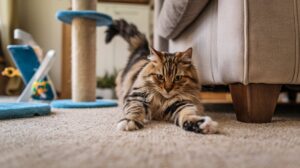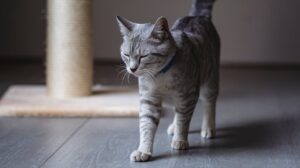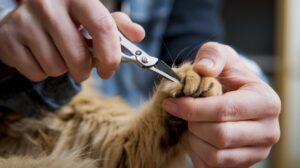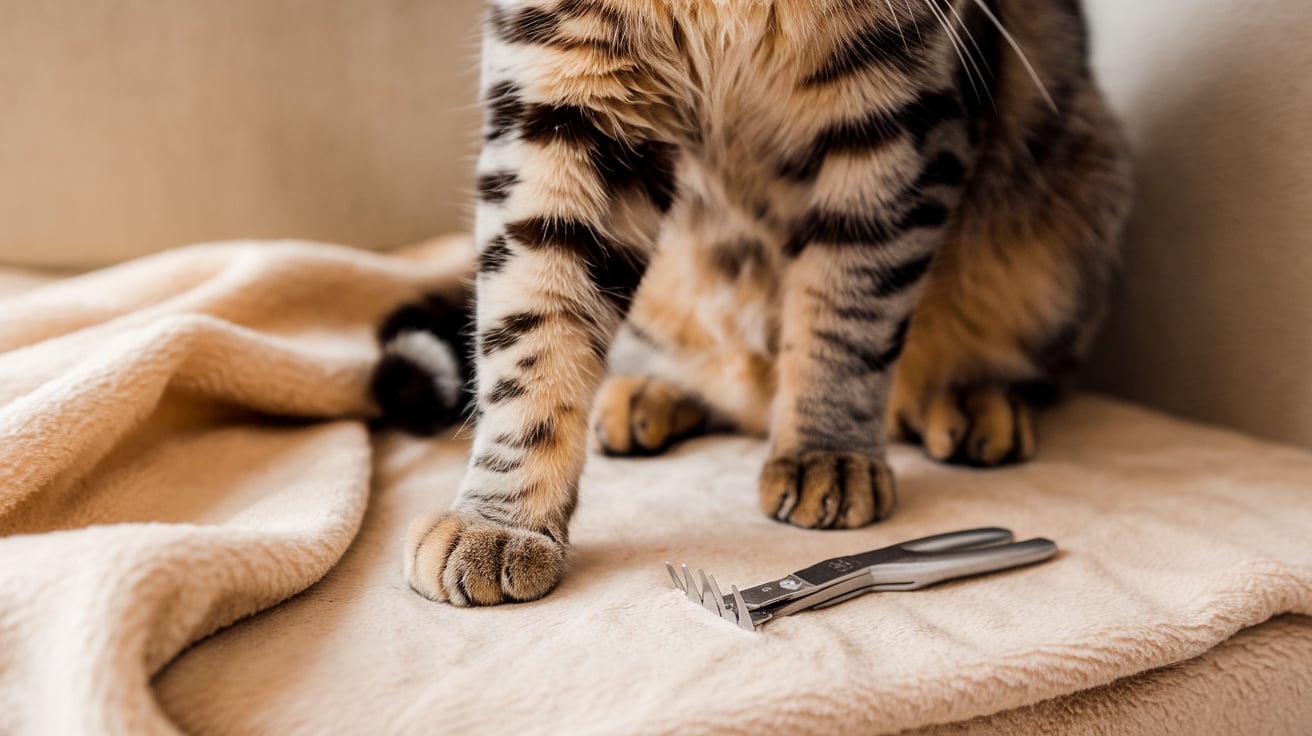Introduction
Cats are cherished companions for many people, offering warmth, playfulness, and companionship. However, along with the joy of having a pet, cat owners often face questions about their care and well-being. One topic that often sparks debate is the issue of clipping cats’ claws. Is it an act of care or cruelty? Many pet owners grapple with this question, wondering if trimming a cat’s claws causes unnecessary harm or discomfort.
The concerns surrounding this practice stem from a desire to ensure that our pets are treated humanely while balancing the need to protect our homes and ourselves from the occasional scratch. Cat lovers often worry whether trimming their pet’s claws will affect their natural behavior or cause them distress, leaving many to ask, “Is clipping cats claws cruel?”We’ll delve more into this subject in the parts that follow, examining all sides of the debate and offering practical advice on ethical cat care.
Natural Behavior of Cats
Cat’s claws play a vital role in their natural behavior, contributing significantly to their daily lives. In the wild, claws are essential tools for hunting, climbing, and self-defense. They allow cats to catch prey, scale trees, and fend off potential threats. Even domesticated cats, despite being well-fed and living in a safe environment, retain these instinctual behaviors. Claws are more than just physical appendages—they’re an integral part of a cat’s identity and survival instincts.
Scratching, another common behavior associated with claws serves a crucial purpose for a cat’s health. It helps them shed dead claw material, keeping their claws sharp and healthy. Moreover, when cats scratch surfaces, they release pheromones from glands in their paws, marking their territory and making them feel secure. This combination of physical maintenance and communication highlights how central claws are to a cat’s overall well-being and natural instincts.
Why Clipping Claws Is Sometimes Necessary
Clipping a cat’s claws is occasionally necessary to prevent overgrown claws, which can lead to pain or injury. When a cat’s claws grow too long, they may curl inward and press into the paw pads, causing discomfort, infections, or even mobility issues. This is particularly common in indoor cats or senior cats who are less active and don’t wear down their claws naturally. Maintaining regular trimming can help keep your cat comfortable and healthy by preventing these unpleasant issues. The cat may bite his nails when it’s overgrown.

Another reason for trimming is to protect household items and the people or pets living with the cat. Cats, especially young or energetic ones, may unintentionally scratch furniture, carpets, or their owners during playtime. Trimming the claws reduces the risk of damage without removing the cat’s ability to scratch entirely. The need for claw care also differs between indoor and outdoor cats; outdoor cats rely more heavily on their claws for climbing and self-defense, while indoor cats may benefit from occasional trimming to prevent accidents or excessive scratching indoors.
In particular, senior or less active cats can be prone to claw overgrowth since they aren’t as physically engaged in activities that naturally wear down their claws. For these cats, regular claw trimming is an important aspect of maintaining their comfort and preventing health issues related to their paws.
Clipping vs Declawing
It’s essential to distinguish between trimming a cat’s claws and declawing, as the two practices are vastly different. Clipping, or trimming, involves carefully cutting the tips of a cat’s claws to prevent them from growing too long or becoming sharp enough to cause harm. This is a minor, non-invasive procedure that leaves the cat’s claws intact, allowing them to continue using them for natural behaviors like scratching, climbing, and self-defense. Clipping is a routine part of grooming that helps ensure a cat’s claws stay healthy without causing discomfort.

Declawing, on the other hand, is a much more severe and controversial procedure. It includes removing the claws by surgically removing the entire final bone on each toe. This is not just a simple nail trim; it’s a permanent alteration of the cat’s paws that can have lasting effects. Declawing is widely considered inhumane because it deprives cats of their natural ability to use their claws, leading to physical and psychological trauma. Cats who undergo declawing often experience chronic pain, difficulty walking, and behavioral issues as they can no longer engage in scratching or defend themselves properly.

Declawing is increasingly condemned by veterinarians and animal welfare organizations as a cruel and unnecessary practice. While trimming claws is a safe and temporary solution, declawing fundamentally alters a cat’s anatomy and can result in long-term suffering.
Best Practices for Clipping Cats’ Claws
Introducing claw clipping early in a cat’s life can make the process much easier and less stressful for both the cat and the owner. Starting when the cat is still a kitten allows them to grow accustomed to the sensation of having their paws handled and their claws trimmed. Regular, gentle handling of the paws can help desensitize them to touch, reducing anxiety during grooming sessions. Using treats and positive reinforcement during these early experiences can create a more relaxed and cooperative environment for future claw trimming.
Choosing the right tools and techniques is also crucial for safe and effective claw trimming. Pet-specific nail clippers or small, sharp scissors designed for cats work best. It’s important to only trim the sharp tip of the claw, avoiding the “quick,” which is the sensitive pink area containing nerves and blood vessels. Accidents can be avoided with patience and a firm but gentle hold on the paw. If you’re unsure about how much to trim, it’s better to take off less and trim more frequently than to risk cutting too deeply.

In some cases, seeking professional help from a vet or groomer may be the best option, especially if your cat becomes highly stressed or resistant. A professional can ensure that the claws are trimmed safely and with minimal discomfort. Additionally, learning to recognize signs of discomfort or distress in your cat—such as pulling their paws away, vocalizing, or showing aggression—can help you know when to stop and reassess the situation. Throughout the process, it’s critical to put your cat’s comfort and well-being first.
Veterinary Perspective on Clipping
From a veterinary perspective, regular claw trimming is an important aspect of responsible pet care. Although the precise frequency can vary depending on the activity level and lifestyle of the cat, veterinarians advise cutting a cat’s claws every one to two weeks. Regular trims help prevent overgrowth, which can lead to painful injuries or infections. By maintaining a routine, pet owners can ensure their cats’ claws are kept at a healthy length, reducing the risk of complications.
Taking good care of your claws has health benefits that go beyond only avoiding overgrowth. Keeping claws trimmed reduces the likelihood of them becoming embedded in the paw pads, which can cause painful infections and injuries. Additionally, for indoor cats, regular trimming helps minimize the risk of scratches, which can be particularly beneficial in multi-pet households where injuries might otherwise occur.
Despite some misconceptions, trimming a cat’s claws is generally not considered cruel when done properly. It is a responsible practice that contributes to a cat’s overall health and well-being. Myths about cruelty often arise from misunderstandings about the difference between safe trimming and harmful practices like declawing. Educating pet owners about the benefits of regular claw maintenance and the correct techniques can help foster a more compassionate approach to pet care.
Conclusion
Clipping a cat’s claws is not inherently cruel when done correctly and with consideration for the cat’s well-being. The practice, when performed gently and regularly, helps prevent overgrowth and related health issues, while also protecting your home and those around you. It is a simple yet effective way to maintain a cat’s comfort and health, contrasting sharply with more severe practices like declawing, which can cause long-term harm.
Ultimately, the key to responsible claw care is to always prioritize the cat’s comfort, behavior, and environment. By starting early, using the right tools, and monitoring your cat’s response, you can ensure that claw trimming remains a positive experience. Understanding and addressing your cat’s specific needs and providing a supportive approach will contribute to their overall well-being, reinforcing the idea that proper claw maintenance is a caring and necessary aspect of pet ownership.
FAQs
How often should I trim my cat’s claws?
Most veterinarians recommend trimming your cat’s claws every 1-2 weeks. The frequency may vary depending on your cat’s activity level and whether they are indoor or outdoor. Regular trims help prevent claws from becoming overgrown and causing discomfort or injury.
Is claw trimming painful for cats?
When done correctly, claw trimming should not be painful for cats. It involves cutting only the sharp tips of the claws and avoiding the “quick,” which contains nerves and blood vessels. If your cat is nervous or uncomfortable, ensure you use proper techniques and go slowly. Positive reinforcement, such as treats, can help make the experience more pleasant.
What should I do if my cat resists claw trimming?
If your cat resists claw trimming, try to make the process more comfortable by handling their paws regularly and gradually introducing the clippers. Start with short, positive sessions and use treats to reward good behavior. If your cat remains highly distressed, consider seeking help from a professional groomer or veterinarian who can assist with the process.
Is it possible to cut my cat’s claws with human nail clippers?
It’s best to use clippers designed specifically for pets, as they are generally safer and more effective for the unique structure of cat claws. Pet nail clippers come in various types, such as guillotine-style or scissor-style, which can help ensure a clean, precise cut without causing harm.
How can I know if the claws on my cat are overgrown?
Overgrown claws may appear long and may curl inward towards the paw pads. You might notice that your cat has difficulty walking or seems to be in pain. Regularly checking the length of the claws and ensuring they are kept at a healthy size can help prevent these issues.
Why is declawing considered inhumane?
Declawing is considered inhumane because it involves the surgical removal of the entire last bone of each toe, which is a painful and irreversible procedure. It can cause long-term physical and behavioral problems, including chronic pain and difficulty walking. Unlike trimming, which is a minor grooming task, declawing fundamentally alters a cat’s anatomy and can lead to significant suffering.
